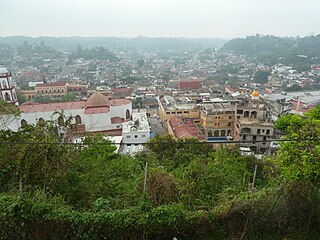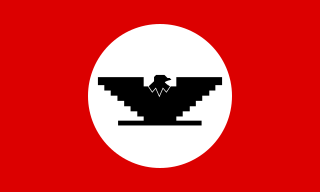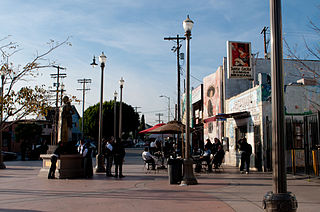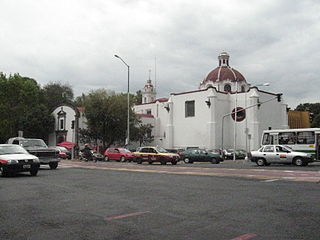
Coyoacán is a borough in Mexico City. The former village is now the borough's "historic center". The name comes from Nahuatl and most likely means "place of coyotes", when the Aztecs named a pre-Hispanic village on the southern shore of Lake Texcoco dominated by the Tepanec people. Against Aztec domination, these people allied with the Spanish, who used the area as a headquarters during the Spanish conquest of the Aztec Empire and made it the first capital of New Spain between 1521 and 1523.

Papantla is a city and municipality located in the north of the Mexican state of Veracruz, in the Sierra Papanteca range and on the Gulf of Mexico. The city was founded in the 13th century by the Totonacs and has dominated the Totonacapan region of the state since then. The region is famed for vanilla, which occurs naturally in this region, the Danza de los Voladores and the El Tajín archeological site, which was named a World Heritage Site. Papantla still has strong communities of Totonacs who maintain the culture and language. The city contains a number of large scale murals and sculptures done by native artist Teodoro Cano García, which honor the Totonac culture. The name Papantla is from Nahuatl and most often interpreted to mean "place of the papanes". This meaning is reflected in the municipality's coat of arms.

The Nuyorican movement is a cultural and intellectual movement involving poets, writers, musicians and artists who are Puerto Rican or of Puerto Rican descent, who live in or near New York City, and either call themselves or are known as Nuyoricans. It originated in the late 1960s and early 1970s in neighborhoods such as Loisaida, East Harlem, Williamsburg, and the South Bronx as a means to validate Puerto Rican experience in the United States, particularly for poor and working-class people who suffered from marginalization, ostracism, and discrimination.

Guerrilla gardening is the act of gardening – raising food, plants, or flowers – on land that the gardeners do not have the legal rights to cultivate, such as abandoned sites, areas that are not being cared for, or private property. It encompasses a diverse range of people and motivations, ranging from gardeners who spill over their legal boundaries to gardeners with a political purpose, who seek to provoke change by using guerrilla gardening as a form of protest or direct action. This practice has implications for land rights and land reform; aiming to promote re-consideration of land ownership in order to assign a new purpose or reclaim land that is perceived to be in neglect or misused. Some gardeners work at night, in relative secrecy, in an effort to make the area more useful or attractive, while others garden during the day for publicity.

A community garden is a piece of land gardened or cultivated by a group of people individually or collectively. Normally in community gardens, the land is divided into individual plots. Each individual gardener is responsible for their own plot and the yielding or the production of which belongs to the individual. In collective gardens the piece of land is not divided. A group of people cultivate it together and the harvest belongs to all participants. Around the world, community gardens exist in various forms, it can be located in the proximity of neighborhoods or on balconies and rooftops. Its size can vary greatly from one to another.

The Royal Chicano Air Force (RCAF) is a Sacramento, California-based art collective, founded in 1970 by Ricardo Favela, José Montoya and Esteban Villa. It was one of the "most important collective artist groups" in the Chicano art movement in California during the 1970s and the 1980s and continues to be influential into the 21st century.

The University City of Caracas, also known by the acronym CUC, is the main campus of the Central University of Venezuela (UCV), located in central Caracas, the capital of Venezuela. It was designed by the Venezuelan architect Carlos Raúl Villanueva and was declared a World Heritage Site by UNESCO in 2000. The Ciudad Universitaria de Caracas is considered a "masterpiece" of architecture and urban planning, and greatly influenced Venezuelan architecture.

Travers Park is a 2-acre (8,100 m2) community park and playground in Jackson Heights, Queens, New York City. It is located between 77th and 78th Streets, on the north side of 34th Avenue. More than half of the park is occupied by an asphalt play area, with basketball and tennis courts. A children's playground with leaf-and-vine shaped spray shower occupies about one third of the park. There are also restroom facilities, handball courts, a dog run, picnic tables, a bicycle rack, benches, tables, and a lawn. In 2012, a segment of adjacent 78th Street was transformed into a permanent Street Plaza; the sports area of a nearby school was also bought by New York City and added to the park.

Mariachi Plaza is a plaza located in the Boyle Heights district of the city of Los Angeles, California. The plaza is known for its history as a center for mariachi music. Since the 1950s, mariachi musicians have gathered in hopes of being hired by visitors who are looking for a full band, trio or solo singer. The plaza resembles Mexico's famed Plaza Garibaldi in both form and function and is also a historic gateway to the neighborhood.

Colonia Doctores is an official neighborhood just southwest of the historic center of Mexico City. It is bordered by Avenida Cuauhtémoc to the west, across from Belen Street to the north, Eje Central to the east and Eje 3 Sur José Peón Contreras to the south.

Seed swaps are events where gardeners meet to exchange seeds. Swapping can be arranged online or by mail, especially when participants are spread out geographically. Swap meet events, where growers meet and exchange their excess seeds in person, are also growing in popularity. In part this is due to increased interest in organic gardening and heritage or heirloom plant varietals. This reflects gardeners' interest in "unusual or particular varieties of flowers and vegetables", according to Kathy Jentz of Washington Gardener Magazine (Maryland).

Balmy Alley is a one-block-long alley that is home to the most concentrated collection of murals in the city of San Francisco. It is located in the south central portion of the Inner Mission District between 24th Street and Garfield Square. Since 1973, most buildings on the street have been decorated with a mural.

Community gardens in the United States benefit both gardeners and society at large. Community gardens provide fresh produce to gardeners and their friends and neighbors. They provide a place of connection to nature and to other people. In a wider sense, community gardens provide green space, a habitat for insects and animals, sites for gardening education, and beautification of the local area. Community gardens provide access to land to those who otherwise could not have a garden, such as apartment-dwellers, the elderly, and the homeless. Many gardens resemble European allotment gardens, with plots or boxes where individuals and families can grow vegetables and flowers, including a number which began as victory gardens during World War II. Other gardens are worked as community farms with no individual plots at all, similar to urban farms.
CHARAS/El Bohio Community Center was a neighborhood organization and squatted community center in New York's East Village between 1979 and 2001.
Taqwa Community Farm is a half-acre park operated as a community garden in the Highbridge neighborhood of the Bronx, New York City.
Community gardens in New York City are urban green spaces created and cared for by city residents who steward the often underutilized land. There are over 550 community gardens on city property, over 745 school gardens, over 100 gardens in land trusts, and over 700 gardens at public housing developments throughout New York City. The community garden movement in NYC began in the Lower East Side during the disrepair of the 1960s on vacant, unused land. These first gardens were tended without governmental permission or assistance.
462 Halsey Community Farm is a community farm in the Bedford-Stuyvesant neighborhood of Brooklyn, New York City. It is located on Halsey Street between Lewis Avenue and Marcus Garvey Boulevard.

Tricia Ward is a Los Angeles-based artist whose work has included public and environmental art, sculpture, and social practice art. She emerged in the 1980s, when collaborations with underserved youth and urban groups that bridged art and social change began to gain institutional attention. Her work combines collaborative, interdisciplinary approaches that include physical transformations of derelict urban environments into "pocket parks," environmental remediation, cultural and educational programming, public policy and civic engagement.
Plaza Verde Park is a park established in 1972 in Pueblo, Colorado.
















